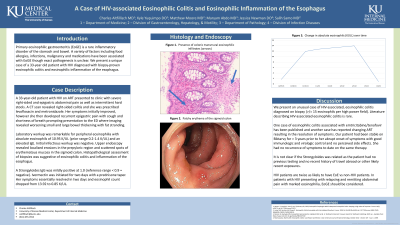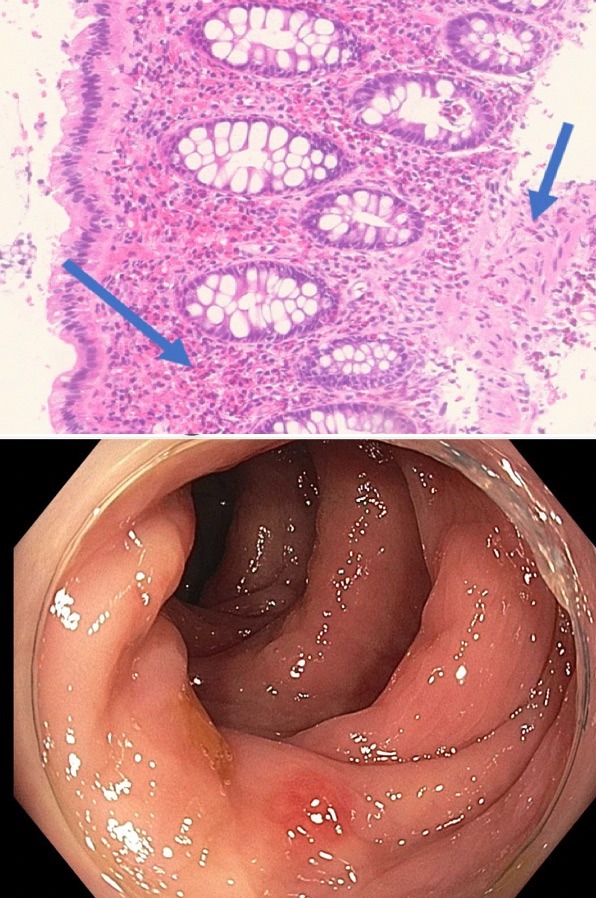Back


Poster Session B - Monday Morning
Category: Colon
B0117 - A Case of HIV-Associated Eosinophilic Gastroenteritis
Monday, October 24, 2022
10:00 AM – 12:00 PM ET
Location: Crown Ballroom

Has Audio

Charlie Altfillisch, MD
University of Kansas Medical Center
Kansas City, MO
Presenting Author(s)
Charlie Altfillisch, MD1, Salih Samo, MD, MSCI2, Kyle Yuquimpo, DO3, Jessica R. Newman, DO4, Maryam Abdo, MBBCh5, Matthew Moore, MD6
1University of Kansas Medical Center, Kansas City, MO; 2University of Kansas Medical Center, Kansas City, KS; 3University of Kansas Medical Center, Lenexa, KS; 4University of Kansas Medical Center, Fairway, KS; 5Kansas University Medical Center, Kansas city, KS; 6University of Kansas Health Systems, Leawood, KS
Introduction: Primary eosinophilic gastroenteritis (EoGE) is a rare inflammatory disorder of the large bowel. A variety of factors including food allergies, infections, malignancy and medications have been associated with EOGE though exact pathogenesis is unclear. We present a unique case of a 33-year old patient with HIV diagnosed with biopsy-proven eosinophilic esophagitis and colitis.
Case Description/Methods: A 33-year-old patient with HIV on ART presented to clinic with a malaise and epigastric abdominal pain. A CT scan revealed colitis and duodenitis and was prescribed antibiotics. Symptoms progressed and she arrived to the ED where repeat imaging revealed worsening small and large bowel thickening with fat stranding. Laboratory workup was remarkable for peripheral eosinophilia with absolute eosinophils of 10.95 K/UL (prior range 0.2-1.4 K/UL) and an elevated IgE. Initial infectious workup was negative. She subsequently underwent endoscopic evaluation. Upper endoscopy revealed localized erosions in the prepyloric region and scattered spots of erythematous mucosa in the sigmoid colon. Histopathological assessment of biopsies was suggestive of eosinophilic esophagitis and colitis. A Strongyloides IgG was mildly positive at 1.0 (reference range < 0.9 = negative). Ivermectin was initiated for two days with a prednisone taper. Her symptoms essentially resolved in two days and eosinophil count dropped from 13.92 to 0.85 K/UL.
Discussion: We present an unusual case of HIV-associated, eosinophilic gastroenteritis diagnosed on biopsy ( >/= 15 eosinophils per high power field). Literature describing HIV-associated EOGE is rare. One case of eosinophilic colitis associated with emtricitabine/tenofovir has been published and another case has reported changing ART resulting in the resolution of symptoms. Our patient had been stable on bictegravir-emtricitabine-tenofovir for > 3 years prior to her abrupt onset of symptoms. It is not clear if the Strongyloides was related as the patient had no previous testing; though had no recent history of travel abroad or other likely recent exposures. HIV patients are twice as likely to have EoE vs non-HIV patients. In patients with HIV presenting with relapsing and remitting abdominal pain with marked eosinophilia, EoGE should be considered.

Disclosures:
Charlie Altfillisch, MD1, Salih Samo, MD, MSCI2, Kyle Yuquimpo, DO3, Jessica R. Newman, DO4, Maryam Abdo, MBBCh5, Matthew Moore, MD6. B0117 - A Case of HIV-Associated Eosinophilic Gastroenteritis, ACG 2022 Annual Scientific Meeting Abstracts. Charlotte, NC: American College of Gastroenterology.
1University of Kansas Medical Center, Kansas City, MO; 2University of Kansas Medical Center, Kansas City, KS; 3University of Kansas Medical Center, Lenexa, KS; 4University of Kansas Medical Center, Fairway, KS; 5Kansas University Medical Center, Kansas city, KS; 6University of Kansas Health Systems, Leawood, KS
Introduction: Primary eosinophilic gastroenteritis (EoGE) is a rare inflammatory disorder of the large bowel. A variety of factors including food allergies, infections, malignancy and medications have been associated with EOGE though exact pathogenesis is unclear. We present a unique case of a 33-year old patient with HIV diagnosed with biopsy-proven eosinophilic esophagitis and colitis.
Case Description/Methods: A 33-year-old patient with HIV on ART presented to clinic with a malaise and epigastric abdominal pain. A CT scan revealed colitis and duodenitis and was prescribed antibiotics. Symptoms progressed and she arrived to the ED where repeat imaging revealed worsening small and large bowel thickening with fat stranding. Laboratory workup was remarkable for peripheral eosinophilia with absolute eosinophils of 10.95 K/UL (prior range 0.2-1.4 K/UL) and an elevated IgE. Initial infectious workup was negative. She subsequently underwent endoscopic evaluation. Upper endoscopy revealed localized erosions in the prepyloric region and scattered spots of erythematous mucosa in the sigmoid colon. Histopathological assessment of biopsies was suggestive of eosinophilic esophagitis and colitis. A Strongyloides IgG was mildly positive at 1.0 (reference range < 0.9 = negative). Ivermectin was initiated for two days with a prednisone taper. Her symptoms essentially resolved in two days and eosinophil count dropped from 13.92 to 0.85 K/UL.
Discussion: We present an unusual case of HIV-associated, eosinophilic gastroenteritis diagnosed on biopsy ( >/= 15 eosinophils per high power field). Literature describing HIV-associated EOGE is rare. One case of eosinophilic colitis associated with emtricitabine/tenofovir has been published and another case has reported changing ART resulting in the resolution of symptoms. Our patient had been stable on bictegravir-emtricitabine-tenofovir for > 3 years prior to her abrupt onset of symptoms. It is not clear if the Strongyloides was related as the patient had no previous testing; though had no recent history of travel abroad or other likely recent exposures. HIV patients are twice as likely to have EoE vs non-HIV patients. In patients with HIV presenting with relapsing and remitting abdominal pain with marked eosinophilia, EoGE should be considered.

Figure: Presence of colonic eosinophilia (arrows) with associated erythema.
Disclosures:
Charlie Altfillisch indicated no relevant financial relationships.
Salih Samo: Castle Biosciences – Advisory Committee/Board Member.
Kyle Yuquimpo indicated no relevant financial relationships.
Jessica Newman indicated no relevant financial relationships.
Maryam Abdo indicated no relevant financial relationships.
Matthew Moore indicated no relevant financial relationships.
Charlie Altfillisch, MD1, Salih Samo, MD, MSCI2, Kyle Yuquimpo, DO3, Jessica R. Newman, DO4, Maryam Abdo, MBBCh5, Matthew Moore, MD6. B0117 - A Case of HIV-Associated Eosinophilic Gastroenteritis, ACG 2022 Annual Scientific Meeting Abstracts. Charlotte, NC: American College of Gastroenterology.
